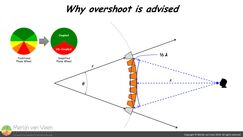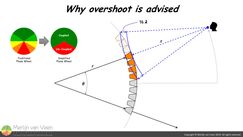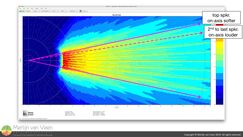By definition, it is impossible to be equally loud on‑axis to the top loudspeaker of a line array, compared to on‑axis to the second‑to‑last loudspeaker. In this short article I will explain why this is, and why overshoot is advised.
For line arrays, the bulk of SPL at a given distance to the array, is primarily caused by those loudspeakers that are coupled, i.e., arrive within 1/3rd cycle or less, and as such, inherently changes with frequency. It is a function of array length, mechanical articulation (splay), and listening distance. Figure 1
Figure 1 Figure 2Figure 1 shows a line array of finite length. On‑axis to the entire array, for the specific wavelength chosen in this example, 7 out of 9 loudspeakers are coupled and cause the bulk of SPL.
Figure 2Figure 1 shows a line array of finite length. On‑axis to the entire array, for the specific wavelength chosen in this example, 7 out of 9 loudspeakers are coupled and cause the bulk of SPL.
In Figure 2, the listener has moved from on‑axis to the entire array, to the edge‑of‑coverage, on‑axis to the upper loudspeaker, while preserving distance.
If the array were not finite but continued to extend, the same amount of loudspeakers would be included in the coupling zone (the green portion of the simplified phase wheel), and SPL would be expected to remain constant.
However, since the array is very much finite, on‑axis to the top loudspeaker, half the required loudspeakers to preserve SPL are missing, and level will drop by 6 dB.
\begin{equation}p_{edge}\propto\frac{n-1}{2n}\end{equation}
Where \(p_{edge}\) is pressure at the edge‑of‑coverage and \(n\) is number of loudspeakers in the line array.
When the number of loudspeakers \(n\) increases, \(p_{edge}\) approaches 0,5 or -6 dB in decibels, which is the required amount of angular attenuation that defines coverage angle.
As frequency increases, wavelengths become shorter, and fewer loudspeakers will be included in the primary coupling zone. Regardless, at the edge‑of‑coverage to your finite array, the coupling zone is always short on loudspeakers. Figure 3Notice that in figure 3, on‑axis to the top (or bottom) loudspeaker, SPL is less than on‑axis to the second‑to‑last loudspeaker. Overshooting by 1 whole loudspeaker would restore the desired sound level.
Figure 3Notice that in figure 3, on‑axis to the top (or bottom) loudspeaker, SPL is less than on‑axis to the second‑to‑last loudspeaker. Overshooting by 1 whole loudspeaker would restore the desired sound level.
